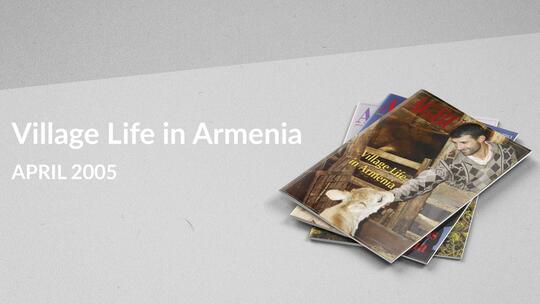by Varant Yessayan
Perhaps the oddest moment during my trip to Armenia came when Stepan, our guide, spiced up the already bumpy drive in his Lada Niva 4x4 by popping a cassette into the car stereo. The chugging riff to Led Zeppelin's "Immigrant Song" punched its way out of the speakers, Robert Plant's inimitable wail filling the cab with electrifying treble. "Live at the Royal Albert Hall," Stepan informed us.
We were on our way from our adoptive village of Shatvan to the nearby village of Marzig, to find two of the oldest dated khatchkars known in Armenia. The sky still heavy with rain and with mud grabbing at our heels, we stepped out of the jeep and began exploring the tiny lot. The khatchkars in the unkempt Marzig cemetery dated back to the 8th century. As I ran my hands over the mossy tuf stone—the rugged, chiseled protrusions like a map beneath my fingers—I could sense the course of history, Armenia's richest attraction.
But then, the Land and Culture Organization's (LCO) Summer 2004 campaign was full of side trips and surprises: a few of them bad, a lot of them wonderful, and every single one memorable. I had arrived in Armenia as an LCO volunteer to help repair the two-story school in Shatvan, a village in Armenia's poorest province, Gegharkunik, located southeast of the resplendent Lake Sevan. Ramshackle outhouses, rough, unyielding terrain, grazing cattle and ubiquitous manure, fresh air and water, overly hospitable people: a mix of clichés of village life struck me across the face as I stepped off the rickety soviet-era bus. Even though I'd mulled over in my head for months what my experience here could be like, and despite the LCO's provision of a detailed plan of our stay, everything still felt unexpected.
To begin, our group was a collection of 15 gems, Armenians from a few different countries and a few different backgrounds. There were some lively Canadians (including one non-Armenian), some colorful Americans, a darling Brit, a boisterous Brazilian and some irrepressible Yerevantsis. With a zany group leader from Lebanon at the helm, our volunteer contingent was a volatile mix of furious fun, laborious enterprise and a few personality clashes.
And then, there was this place: Shatvan. A place of both immovable beauty and unrelenting hardship. As every morning was a warm embrace from the sky, so every evening was a chilly reminder of the village's seat at 2100 metres above sea level. The houses were Azeri-built, inherited reluctantly as a consequence of the Armenian-Azeri swap of the Karabakh war exodus. Most of the homes were haphazardly slapped together with uneven concrete, and a few were simply abandoned to their dilapidated states. The school itself was a wreck, a ruin that wouldn't pass the most basic safety requirements of our comfortable society's civil inspectors. And yet... And yet, the children who studied there through frigid winters still smiled, and their eyes shined like beacons from the soul. They were excited by our presence, intrigued by our existence back home and by how foreign to each other two Armenians could feel standing side-by-side in the beautiful fatherland.
Of course, there was the mystifying landscape. The panoramas drawn up with the sun in the morning were breathtaking: a froth of clouds pouring over the mountaintops, the haunting rush of wind through slender trees like the rise and crash of waves, unending horizons of green, yellow and ocher fields, a sprawling expanse of haloed lushness and an overpowering range of mountains. These were the staple backdrops of this surreal place, stuck in time.
A friend from Yerevan had told me that everything has an actual taste in Armenia. He could not have understated it more. Every morning, we had a feast of freshness, thanks to the LCO and our surrogate mother, Shoushan: lavash—a thin, chewy, wrap-like bread sometimes picked up at a neighbour's tonir on our way back home—eggs and soujouk, goat cheese, the sweetest apricots, peaches and cherries, delectable tomatoes, crisp cucumbers and fragrant mint leaves. And what had become perhaps the best-tasting Yellow Label Lipton tea known to man. So much plenty with so little. And that went for emotions, too.
We worked hard on the school that summer, the toiling made even more difficult by the lack of tools, and sometimes, of direction. Waking up to a set regimen took some getting used to. Straining to understand the locals—though our language was essentially the same—was for some disheartening. Occasionally, the harsh reality of these peoples' everyday would hit like a double-fisted punch to the gut. But through it all, we gained a better understanding of what our homeland really means to each of us. On day trips to awe-inspiring monasteries, during picnics near gorgeous foothills and in the midst of lush forests, or through the manic drunkenness of nights spent around a campfire, the LCO campaign allowed us to be privy to an Armenia that was miles away from the conventional and provided us with unique insight and unmistakable outlook on a fatherland so venerated.
Oh yeah... And the school? It's now safer, sturdier and warmer than ever, the LCO seal of hard work forever embedded in its foundations. Literally...
Varant Yessayan was a volunteer with the Land and Culture Organization during the month of July 2004 working on the renovation project of the school building in the village of Shatvan, southeast of Lake Sevan. He attends Concordia University in Montreal, Canada.






